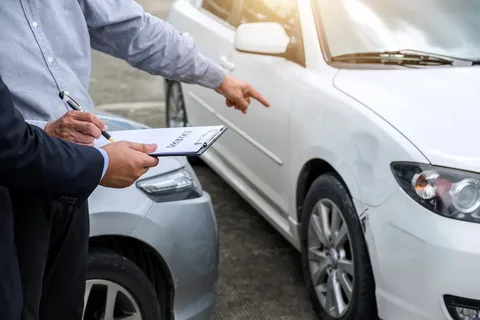Auto insurance—it’s that necessary evil that we all need but love to hate. It’s like a gym membership; you know you need it, but you’d rather not think about it. Whether you’re a seasoned driver or a newbie who’s just hit the road, understanding auto insurance can feel like trying to read the fine print on a soda can. But fear not! This guide will walk you through everything you need to know about auto insurance, with a bit of humor to keep things light.

What Is Auto Insurance and Why Do You Need It?
First things first: What is auto insurance? In simple terms, auto insurance is a contract between you and an insurance company that protects you financially in case of accidents, theft, or other mishaps involving your vehicle. You pay a premium, and in return, the insurance company agrees to cover certain costs associated with damage or loss.
Why do you need it? Well, besides the fact that it’s illegal to drive without it in most places (no one wants a hefty fine or their car impounded), auto insurance gives you peace of mind. It’s like a safety net for your wallet. If you get into an accident, your insurance can cover the costs of repairs, medical bills, and even legal fees if you’re sued. Without it, you could be on the hook for thousands—or even tens of thousands—of dollars. Ouch!
External Link: For a detailed breakdown of how auto insurance works, check out this resource.
Types of Auto Insurance Coverage
Auto insurance isn’t one-size-fits-all. There are several types of coverage, each designed to protect you in different situations. Let’s break it down:
- Liability Insurance: This is the biggie, and in most places, it’s required by law. Liability insurance covers the costs if you’re at fault in an accident and you damage someone else’s property or injure someone. It’s like saying, “My bad! Here’s the cash to fix it.”
- Collision Insurance: Ever had that “oops” moment where you bump into another car, a tree, or even a mailbox? Collision insurance covers the cost of repairing or replacing your vehicle after a collision, regardless of who’s at fault.
- Comprehensive Insurance: Think of this as the “everything else” insurance. It covers damage to your car from non-collision-related events like theft, vandalism, natural disasters, or that time a deer decided to cross the road at the worst possible moment.
- Personal Injury Protection (PIP): Also known as “no-fault insurance,” PIP covers medical expenses and lost wages for you and your passengers, regardless of who caused the accident. It’s your personal health coverage on wheels.
- Uninsured/Underinsured Motorist Coverage: What if the person who hits you doesn’t have insurance, or their coverage isn’t enough to cover your damages? This coverage steps in to fill the gap, so you’re not left footing the bill.
- Gap Insurance: If you’re financing or leasing your car, gap insurance is a must. It covers the difference between what you owe on your car and its actual cash value if it’s totaled in an accident. This way, you’re not stuck paying for a car you no longer have.
External Link: For a deep dive into the different types of auto insurance coverage, visit this page.

How to Choose the Right Auto Insurance Coverage
Choosing the right auto insurance coverage can feel like navigating a maze. Here’s a simple guide to help you out:
- Assess Your Needs: Are you driving a brand-new Tesla or a decade-old Honda? The type of car you drive, how often you drive, and where you live all play a role in determining what coverage you need. For example, if you’re driving an older car, you might not need comprehensive or collision coverage.
- Set Your Budget: Auto insurance premiums can vary widely based on the coverage you choose. Determine how much you can afford to pay in premiums and how much you’re willing to pay out-of-pocket in case of an accident (your deductible).
- Compare Quotes: Don’t settle for the first quote you get. Shop around and compare quotes from different insurers. You might be surprised at the difference in prices for the same coverage.
- Check for Discounts: Many insurers offer discounts for things like safe driving, bundling auto insurance with other policies, or even just for being a good student. Be sure to ask about any discounts you might qualify for.
- Read the Fine Print: This is the boring but crucial part. Make sure you understand what is and isn’t covered by your policy, as well as any exclusions or limitations.
External Link: For tips on how to choose the right auto insurance, you can explore this comprehensive guide.
Factors That Affect Your Auto Insurance Premiums
Ever wondered why your friend’s auto insurance costs less than yours, even though you both have the same car? Auto insurance premiums are determined by a variety of factors, some of which might surprise you:
- Driving Record: If you have a history of speeding tickets or accidents, you’re considered a higher risk, and your premiums will reflect that.
- Age and Gender: Younger drivers (especially males) tend to pay more because they’re statistically more likely to be involved in accidents. Sorry, young dudes—it’s just the way the cookie crumbles.
- Location: Where you live matters. If you live in an area with high crime rates or a lot of traffic, you’ll pay more for auto insurance. Urban dwellers, beware!
- Type of Vehicle: Some cars are more expensive to insure than others. Sports cars, luxury vehicles, and cars with high theft rates will cost more to insure.
- Credit Score: Believe it or not, your credit score can affect your auto insurance premiums. Insurers believe that people with higher credit scores are more responsible and less likely to file claims.
- Driving Habits: How often you drive and the distances you cover can also impact your premiums. If you have a long daily commute, you might pay more than someone who only drives on weekends.
External Link: To learn more about the factors that affect auto insurance premiums, visit this article.
Common Auto Insurance Myths—Busted!
There’s a lot of misinformation floating around about auto insurance. Let’s clear up some of the most common myths:
- Myth: Red Cars Cost More to Insure
Busted: The color of your car has absolutely no impact on your insurance premiums. Whether you’re driving a red Ferrari or a blue Honda, your rates are based on factors like the make, model, and age of the car—not its color. - Myth: Your Insurance Covers Everything
Busted: Not necessarily. While full coverage sounds like it should cover everything, there are still exclusions and limitations. Always read the fine print to know what’s actually covered. - Myth: Your Rates Increase Automatically After an Accident
Busted: Not always. If you have accident forgiveness on your policy, your first accident might not affect your rates. However, multiple accidents or serious violations will likely result in higher premiums. - Myth: Older Drivers Always Pay More
Busted: While older drivers might see their premiums increase slightly as they age, many insurers offer discounts for seniors, especially those with clean driving records. - Myth: Comprehensive Insurance Covers Everything
Busted: Comprehensive insurance covers non-collision-related damage, but it doesn’t cover things like wear and tear or mechanical breakdowns. It’s comprehensive, not all-encompassing.
External Link: For more auto insurance myths and facts, check out this resource.

Tips for Lowering Your Auto Insurance Premiums
Want to save some money on your auto insurance? Here are some practical tips:
- Bundle Your Policies: If you have multiple insurance policies (like home and auto), consider bundling them with the same insurer. Many companies offer discounts for bundling.
- Increase Your Deductible: If you can afford to pay more out-of-pocket in the event of a claim, increasing your deductible can lower your premiums.
- Maintain a Good Credit Score: Since your credit score can affect your premiums, keeping it in good shape can help you get better rates.
- Take a Defensive Driving Course: Some insurers offer discounts to drivers who complete a defensive driving course. It’s a win-win: you become a safer driver and save money!
- Drive Safely: This one’s a no-brainer. The longer you go without accidents or traffic violations, the lower your premiums will be.
External Link: For more ways to save on auto insurance, visit this guide.
The Claims Process: What to Do After an Accident
No one likes to think about getting into an accident, but it’s important to know what to do if it happens. Here’s a step-by-step guide to the auto insurance claims process